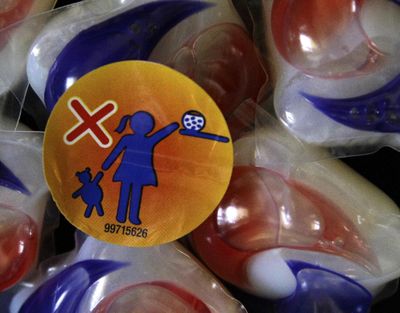The murky facts of the ‘deodorant challenge’ – and other viral teen ‘crazes’

A mother in Britain was furious: Her daughter’s arm was maimed with a nasty, blistery burn. And the burn was thanks to something called the “deodorant challenge.”
So the mom did what many parents might do in 2018: She warned the internet about it.
“For any parents who have children, please, please sit them down and show them these pictures. . …These are the damaging results of something known as ‘The Deodorant Challenge’,” Jamie Prescott wrote on Facebook last week. Prescott said the challenge was “currently doing the rounds in Yate,” a small city outside Bristol, “and literally involves spraying deodorant on to someone else for as long as possible.”
The damage caused by the deodorant challenge is very real. It comes not from the deodorant itself, but from the delivery method. An aerosol spray cools quickly on the skin, essentially producing frostbite. The result can be, essentially, a burn, according to a cautionary post from the University of Utah. The longer the spray on the skin, the worse the damage.
The post has more than 4,000 shares on Facebook, and has become the main source for a wave of news articles warning about a dumb thing teens were doing because of the internet. The Sacramento Bee called it a “dangerous fad.” The International Business Times said it was a “craze.” Another article called the deodorant challenge the “latest teen trend.”
Dumb and dangerous online teen challenges are repeat visitors to the news cycle. And they bring with them a whole world of factual murkiness. In this case, as in many others, the challenge itself appears to be real, and dangerous. But there’s little definitive evidence that it has actually gone viral among teenagers in Britain or elsewhere on social media. Instead, the thing that trends is often the warning about the challenge.
Google Trends shows search interest climbing for “deodorant challenge” after Prescott’s warning started getting media attention, with relatively little interest before that. The search term previously peaked in search interest in 2017, when the last panic about the challenge spread through the news. ITV called it the “social media craze that’s burning children’s’ skin,” and interviewed a mother and daughter about it back then. The mother posted a picture of her daughter’s burns to Facebook. The daughter said she tried the challenge because her friends were doing it.
Similarly, Prescott’s daughter Ellie heard about the challenge from her friends. But the connection to a currently viral teen social media challenge is unproven.
There’s not a ton of research on the phenomenon. One study, published in the scientific journal “Burns and Trauma” in 2016, traced cases of cold burns at a regional burn unit in Britain for an 11-year period. The researchers found that of the 11,468 burn patients treated at the center during the study period, a total of 23 of them were cold burns. The study ran until December of 2014, or 11 months after the Daily Mail first warned that the “deodorant challenge” was a teen “craze” on YouTube, inspiring hordes of teens to try the dangerous idea. The study’s findings hardly support that warning – instead, researchers wrote that cold burns were “uncommon.”
However, the research did find some evidence that a small number of kids were trying this, whether because of the challenge or otherwise: Of the patients who were between 15-25 years old with cold burns, “90% of admissions were due to deliberate self-inflicted injuries using deodorant sprays.”
On Youtube, there are some videos of kids showing their injuries from the challenge going back five years, but none seem to have gone “viral” – their view counts are in the hundreds or low thousands. There are also plenty of videos warning about the challenge uploaded to YouTube in the past 24 hours. And there are a handful of videos of young British tweens doing a different “deodorant challenge,” which involves trying to guess a deodorant brand by spraying it into the air and smelling it. Other enterprising teens have posted videos of themselves attempting to take a bite of deodorant.
Basically, the deodorant challenge is real, but the warnings appear to be more viral than the challenge itself. And it’s hardly the only teen challenge to be propelled into the news cycle in this way.
Last month, there was a massive moral panic about the “condom challenge,” where teens snort a condom up their nose. Yes, people really have done this on the internet, and yes, it is incredibly dangerous. But even as the “condom challenge” swept through the news cycle, there was no evidence to suggest that the years-old dumb idea on the internet was actually seeing a revival among teens.
The Washington Post traced the origins of last month’s panic about the condom challenge to a single PowerPoint presentation in San Antonio, Texas, part of a workshop for local parents on dangers teens might face online. The presentation, and the original local news report about it, never claimed that the challenge was “viral.” That word was appended to the story as it spread through the online news landscape.
And then there was the spread of the Tide Pod Challenge, probably the most popular meme of 2018 for adults who want to mock dumb teens – even though my colleague reported at the time that laundry pod poisonings are actually trending downward
“The word ‘trend’ is the most important aspect of these stories,” said Alex Kasprak, a reporter at Snopes, a fact-checking site, told The Post last month. As the condom challenge spread, Snopes rated the news as “mostly false.” The kernel of truth was that the condom challenge was real and dangerous. The trend itself was false, but spread, Kasprak notes, “because ‘kids are so dumb’ is a real popular thing to talk about.”